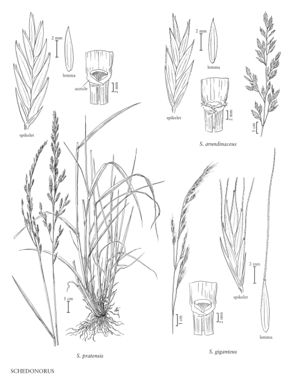Difference between revisions of "Schedonorus arundinaceus"
FNA>Volume Importer |
imported>Volume Importer |
||
| (8 intermediate revisions by 2 users not shown) | |||
| Line 7: | Line 7: | ||
|synonyms={{Treatment/ID/Synonym | |synonyms={{Treatment/ID/Synonym | ||
|name=Lolium arundinaceum | |name=Lolium arundinaceum | ||
| − | |authority= | + | |authority= |
| − | }}{{Treatment/ID/Synonym | + | |rank=species |
| + | }} {{Treatment/ID/Synonym | ||
|name=Festuca elatior var. arundinacea | |name=Festuca elatior var. arundinacea | ||
| − | |authority= | + | |authority= |
| − | }}{{Treatment/ID/Synonym | + | |rank=variety |
| + | }} {{Treatment/ID/Synonym | ||
|name=Aristata | |name=Aristata | ||
| − | |authority= | + | |authority= |
| − | }}{{Treatment/ID/Synonym | + | |rank=forma |
| + | }} {{Treatment/ID/Synonym | ||
|name=Festuca elatior | |name=Festuca elatior | ||
| − | |authority= | + | |authority= |
| − | }}{{Treatment/ID/Synonym | + | |rank=species |
| + | }} {{Treatment/ID/Synonym | ||
|name=Festuca arundinacea | |name=Festuca arundinacea | ||
| − | |authority= | + | |authority= |
| + | |rank=species | ||
}} | }} | ||
|hierarchy=Poaceae;Poaceae subfam. Pooideae;Poaceae tribe Poeae;Schedonorus;Schedonorus arundinaceus | |hierarchy=Poaceae;Poaceae subfam. Pooideae;Poaceae tribe Poeae;Schedonorus;Schedonorus arundinaceus | ||
| Line 31: | Line 36: | ||
-->{{Treatment/Body | -->{{Treatment/Body | ||
| − | |distribution=Conn.;N.J.;N.Y.;Wash.;Del.;D.C;Wis.;W.Va.;Pacific Islands (Hawaii);Md.;Fla.;Wyo.;N.H.;N.Mex.;Tex.;La.;N.C.;Kans.;Nebr.;Tenn.;Alta.;B.C.;N.B.;Nfld. | + | |distribution=Conn.;N.J.;N.Y.;Wash.;Del.;D.C.;Wis.;W.Va.;Pacific Islands (Hawaii);Md.;Fla.;Wyo.;N.H.;N.Mex.;Tex.;La.;N.C.;Kans.;Nebr.;Tenn.;Alta.;B.C.;N.B.;Nfld. and Labr. (Labr.);N.S.;Ont.;Que.;Sask.;Yukon;Pa.;Alaska;Nev.;Va.;Colo.;Calif.;Ala.;Ark.;Vt.;Ill.;Ga.;Iowa;Okla.;Ariz.;Idaho;Maine;Mont.;Oreg.;Mass.;Ohio;Utah;Mo.;Minn.;Mich.;Miss.;S.C.;Ky.;S.Dak. |
| − | |discussion=<p>Schedonorus arundinaceus is a Eurasian species that has been introduced to the Flora region. It is grown for forage, soil stabilization, and coarse turf. It is now cultivated in all but the coldest and most arid parts of North America, and often escapes. It is frequently infected with the endophytic fungi Neotyphodium coenophialum, which confers insect and drought resistance to the plant, among other benefits; it also produces ergot alkaloids that are toxic to livestock. Varieties with endophyte strains that do not produce toxic ergot alkaloids have been developed (Nihsen et al. 2004).</p> | + | |discussion=<p><i>Schedonorus arundinaceus</i> is a Eurasian species that has been introduced to the Flora region. It is grown for forage, soil stabilization, and coarse turf. It is now cultivated in all but the coldest and most arid parts of North America, and often escapes. It is frequently infected with the endophytic fungi Neotyphodium coenophialum, which confers insect and drought resistance to the plant, among other benefits; it also produces ergot alkaloids that are toxic to livestock. Varieties with endophyte strains that do not produce toxic ergot alkaloids have been developed (Nihsen et al. 2004).</p> |
|tables= | |tables= | ||
|references= | |references= | ||
| Line 41: | Line 46: | ||
-->{{#Taxon: | -->{{#Taxon: | ||
name=Schedonorus arundinaceus | name=Schedonorus arundinaceus | ||
| − | |||
|authority=(Schreb.) Dumort. | |authority=(Schreb.) Dumort. | ||
|rank=species | |rank=species | ||
| Line 48: | Line 52: | ||
|basionyms= | |basionyms= | ||
|family=Poaceae | |family=Poaceae | ||
| − | |distribution=Conn.;N.J.;N.Y.;Wash.;Del.;D.C;Wis.;W.Va.;Pacific Islands (Hawaii);Md.;Fla.;Wyo.;N.H.;N.Mex.;Tex.;La.;N.C.;Kans.;Nebr.;Tenn.;Alta.;B.C.;N.B.;Nfld. | + | |illustrator=Annaliese Miller |
| + | |illustration copyright=Utah State University | ||
| + | |distribution=Conn.;N.J.;N.Y.;Wash.;Del.;D.C.;Wis.;W.Va.;Pacific Islands (Hawaii);Md.;Fla.;Wyo.;N.H.;N.Mex.;Tex.;La.;N.C.;Kans.;Nebr.;Tenn.;Alta.;B.C.;N.B.;Nfld. and Labr. (Labr.);N.S.;Ont.;Que.;Sask.;Yukon;Pa.;Alaska;Nev.;Va.;Colo.;Calif.;Ala.;Ark.;Vt.;Ill.;Ga.;Iowa;Okla.;Ariz.;Idaho;Maine;Mont.;Oreg.;Mass.;Ohio;Utah;Mo.;Minn.;Mich.;Miss.;S.C.;Ky.;S.Dak. | ||
|reference=None | |reference=None | ||
|publication title= | |publication title= | ||
|publication year= | |publication year= | ||
|special status= | |special status= | ||
| − | |source xml=https:// | + | |source xml=https://bitbucket.org/aafc-mbb/fna-data-curation/src/200273ad09963decb8fc72550212de541d86569d/coarse_grained_fna_xml/V24/V24_636.xml |
|subfamily=Poaceae subfam. Pooideae | |subfamily=Poaceae subfam. Pooideae | ||
|tribe=Poaceae tribe Poeae | |tribe=Poaceae tribe Poeae | ||
Latest revision as of 16:24, 11 May 2021
Plants perennial, sometimes rhizomatous. Culms to 1.5(2) m. Leaves convolute in young shoots; auricles ciliate, having at least 1 or 2 hairs along the margins; ligules 1(2) mm; blades 11-30 cm long, 4-12 mm wide. Panicles 10-35 cm; branches at the lowest node usually 2, shorter branch with (1)2-9(13) spikelets, longer branch with (3)4-13(19) spikelets. Spikelets 8-15.5 mm long, 2-3.5 mm wide, with 3-6(9) florets. Lower glumes 3-6 mm; upper glumes 4.5-7(9) mm; lemmas (4)5-9(11.5) mm, usually scabrous or hispidulous, at least distally, rarely smooth, awns absent or to 4 mm, terminal or attached up to 0.4 mm below the apices; paleas slightly shorter than to slightly longer than the lemmas; anthers 2.5-4 mm. Caryopses 2-4 mm long, 0.9-1.6 mm wide. 2n = 28, 42, 56, 63, 70.
Distribution
Conn., N.J., N.Y., Wash., Del., D.C., Wis., W.Va., Pacific Islands (Hawaii), Md., Fla., Wyo., N.H., N.Mex., Tex., La., N.C., Kans., Nebr., Tenn., Alta., B.C., N.B., Nfld. and Labr. (Labr.), N.S., Ont., Que., Sask., Yukon, Pa., Alaska, Nev., Va., Colo., Calif., Ala., Ark., Vt., Ill., Ga., Iowa, Okla., Ariz., Idaho, Maine, Mont., Oreg., Mass., Ohio, Utah, Mo., Minn., Mich., Miss., S.C., Ky., S.Dak.
Discussion
Schedonorus arundinaceus is a Eurasian species that has been introduced to the Flora region. It is grown for forage, soil stabilization, and coarse turf. It is now cultivated in all but the coldest and most arid parts of North America, and often escapes. It is frequently infected with the endophytic fungi Neotyphodium coenophialum, which confers insect and drought resistance to the plant, among other benefits; it also produces ergot alkaloids that are toxic to livestock. Varieties with endophyte strains that do not produce toxic ergot alkaloids have been developed (Nihsen et al. 2004).
Selected References
None.
